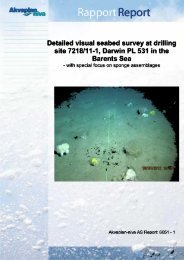A study of the priority substances of the Water Framework Directive ...
A study of the priority substances of the Water Framework Directive ...
A study of the priority substances of the Water Framework Directive ...
Create successful ePaper yourself
Turn your PDF publications into a flip-book with our unique Google optimized e-Paper software.
..:::::::::: octylphenols<br />
..:::62<br />
25 Octylphenols<br />
� Very limited data is available on octylphenol,<br />
but <strong>the</strong> effects are probably similar to nonylphenols.<br />
� Octylphenol is known to have similar use as<br />
nonylphenols but it is less used.<br />
� 4-tert-octylphenol may form in waste water<br />
via degradation <strong>of</strong> some alkylphenols.<br />
� Fur<strong>the</strong>r screening is necessary.<br />
Production and use<br />
In Norway, no use is known today, but ethoxylates<br />
may be present in some imported products.<br />
Imports and use are regulated (mainly banned)<br />
since 2002, and <strong>the</strong>re is a national target for<br />
phasing out by 2005. See fact sheet 24.<br />
Emissions, discharges,<br />
distribution and hot-spots<br />
Octylphenols are discharged to waste water or<br />
may be formed as a degradation product <strong>of</strong><br />
alkylphenols in waste water; <strong>the</strong> main sources<br />
are garages, car-wash installations etc. and<br />
households, as for nonylphenols. Octylphenols -<br />
Ethoxylates are found in sludge from municipal<br />
waste water treatment plants. There are no data<br />
on environmental distribution. See fact sheet 24.<br />
Need for fur<strong>the</strong>r screening and monitoring<br />
Octylphenols should be screened toge<strong>the</strong>r with<br />
nonylphenols, at <strong>the</strong> same localities.<br />
Analysis<br />
The analysis <strong>of</strong> octylphenols is <strong>of</strong>ten part <strong>of</strong><br />
multi phenols packages <strong>of</strong>fered by several laboratories.<br />
Methods<br />
The methods are based on direct extraction with<br />
an organic solvent (sediment and biota) or solid<br />
phase extraction (SPE), clean-up with SPE and<br />
separation and quantification with ei<strong>the</strong>r GCor<br />
LC-based methods: GC/MS, LC/MS or<br />
LC/UV.<br />
Synergy with o<strong>the</strong>r analyses<br />
Sample extraction and clean-up may be co-ordinated<br />
with <strong>the</strong> analysis <strong>of</strong> o<strong>the</strong>r phenols as<br />
nonylphenol or pentachlorophenol.<br />
A <strong>study</strong> <strong>of</strong> <strong>the</strong> <strong>priority</strong> <strong>substances</strong> <strong>of</strong> <strong>the</strong> <strong>Water</strong> <strong>Framework</strong> <strong>Directive</strong><br />
TA-2140/2005<br />
FACTS<br />
Cas no.: 4-tert-octylphenol: 140-66-9<br />
octylphenol: 67554-50-1<br />
p-octylphenol: 1806-26-4<br />
1,1,3,3-tetramethylbutylphenol: 27193-28-8<br />
Synonyms: di-iso-butylphenol, para-octylphenol, OP,<br />
1,1,3,3-tetramethyl-4-butylphenol<br />
Properties:<br />
Toxic effects: 4-tert-octylphenol is a skin and eye irritant.<br />
Octylphenols are on <strong>the</strong> EU list <strong>of</strong> endocrine disruptors.<br />
Log Kow: 5,28 (4-tert-octylphenol)<br />
Persistence: Octylphenols are inherently biodegradable<br />
with > 60 % (35 days) in mod. Sturm-test (OECD<br />
301B) (CIRCA). Photodegradation in air is 9 hours.<br />
Octylphenols bioaccumulate in aquatic organisms.<br />
<strong>Water</strong> solubility: 5 mg/l at 25° C (4,821 mg/l for 4-tert)<br />
Molecular formula: C 14 H 22 O<br />
Metabolites: See nonyphenols, fact sheet 24<br />
References<br />
� Miljøstatus: Nonyl- og oktylfenoler.<br />
� CIRCA, Royal Haskoning Fact sheets on production,<br />
use and release <strong>of</strong> <strong>priority</strong> <strong>substances</strong> in<br />
<strong>the</strong> WFD, Octylphenol, Final version 31<br />
January 2001.<br />
� HSDB: 4-tert-octylphenol 140-66-9 and<br />
octylphenol 67554-50-1.<br />
� European Commission 1999; Study on <strong>the</strong><br />
prioritisation <strong>of</strong> <strong>substances</strong> dangerous to <strong>the</strong><br />
aquatic environment. (98/88/3040/DEB/E1).<br />
� Environmental Review no. 15, 2004, EU-List<br />
<strong>of</strong> Undesirable Substances 2004<br />
� Paulsrud, Bjarne; Nedland, Kjell Terje; Wien,<br />
Asgeir: Organiske miljøgifter i norsk avløpsslam.<br />
SFT-rapport 97:25, TA-1472.<br />
� Nesgård, Bjørg Synnøve; Røstad, Astrid;<br />
Lima-Charles, Michael: Kilder til organiske<br />
miljøgifter i kommunalt avløpsvann - bidrag fra<br />
småindustri. SFT-rapport 98:22.<br />
� Lima-Charles, Michael; Nesgård, Bjørg<br />
Synnøve: Kilder til organiske miljøgifter i kommunalt<br />
avløpsvann: bidrag fra husholdninger.<br />
SFT-rapport 98:23, TA-1590.

















